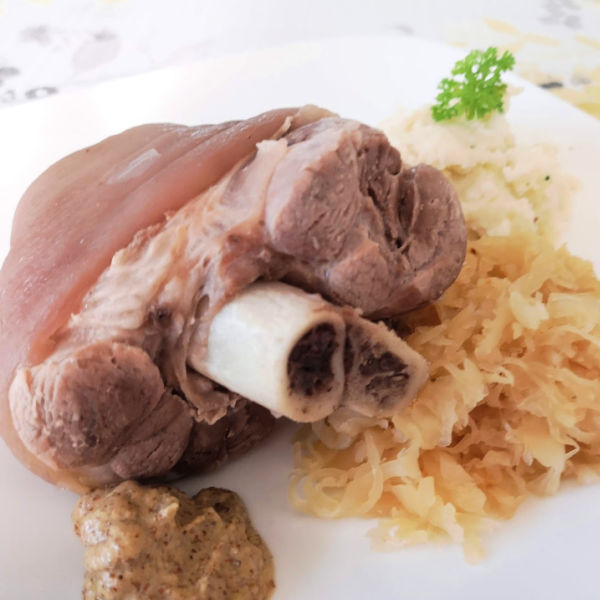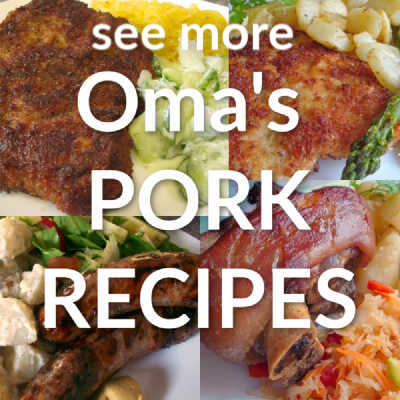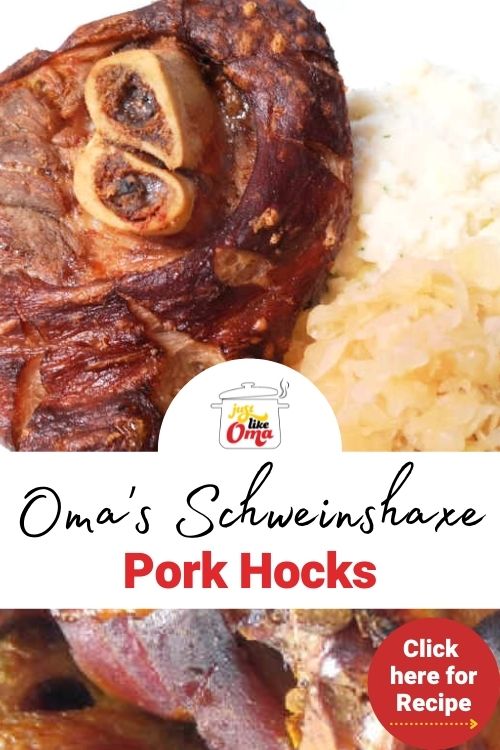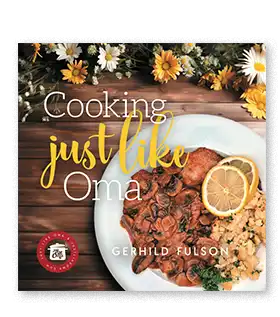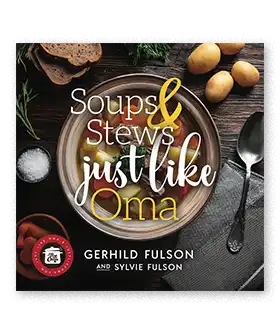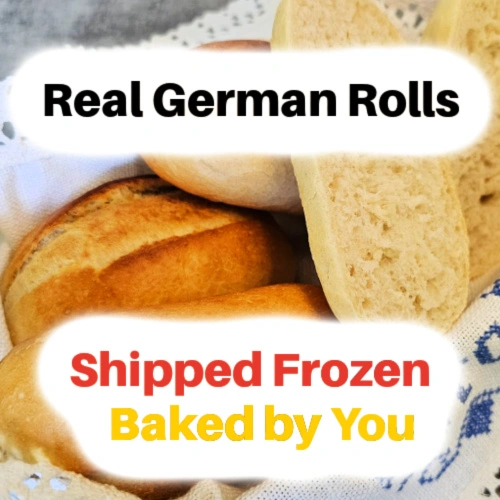Spice up your inbox with FREE German recipes and an exclusive free recipe ebook!
Warm up this winter with Oma's newest cookbooks - available on Amazon >>
Spice up your inbox with FREE German recipes and an exclusive free recipe ebook!
- Home
- German Pork Recipes
- Pork Hocks Recipe
Roasted German Pork Hocks (Schweinshaxe)

by: Gerhild Fulson / Oma Gerhild shares German recipes rooted in family tradition.
Updated: January 20, 2025
This German pork hocks recipe (schweinshaxe) makes crispy skin and tender meat easy. With Oma’s tips, you’ll have a Bavarian classic on the table in no time!
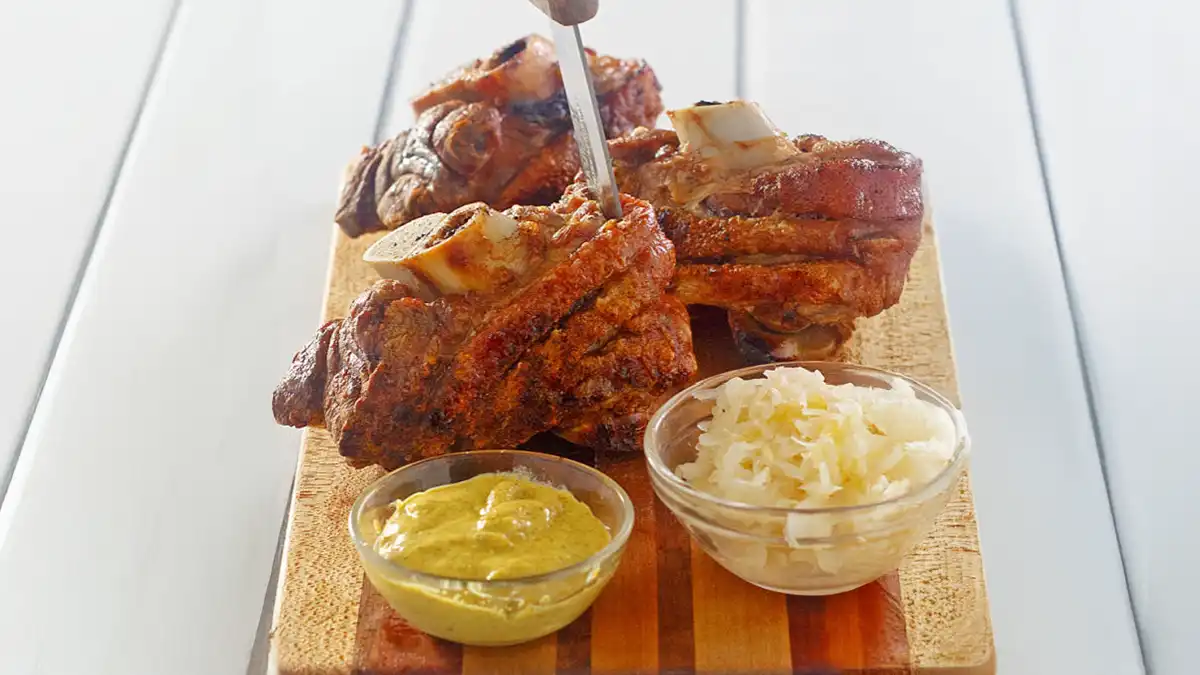 Bavarian-style crispy-skinned pork hocks ... That knife embedded ... so traditional!
Bavarian-style crispy-skinned pork hocks ... That knife embedded ... so traditional!German pork hock, also known as schweinshaxe or pork knuckle, is a traditional dish in Bavarian cuisine. This crispy, yet tender classic meat is perfect for hearty meals and festive occasions like Oktoberfest.
Whether you're new to this traditional pork hocks recipe or looking to perfect your technique, below you'll find step-by-step instructions as well as pairing suggestions and more.
Oma's Recipe Rundown
- Ease of Making: Moderate; simple steps, but requires time and patience
- Taste: A hearty, flavorful dish with crispy skin and tender meat.
- Time: Approximately 3 hours and 45 minutes from start to finish
- Best Served With: Sauerkraut, potato dumplings, or a hearty beer gravy
- Gluten-Free: Use gluten-free beer for the gravy
Top Tips For The Best Results
- Use Beer for Extra Flavor: Roasting the hocks with beer enhances the depth of flavor.
- Dry Skin Thoroughly: For the crispiest crackling, ensure the skin is dry before roasting.
- Rest Before Serving: Let the cooked hocks rest for 10 minutes before slicing to retain juices.
- Use a Meat Thermometer: Ensure the internal temperature reaches at least 75°C (165°F) for perfect doneness.
Southern German Versus Northern German Pork Hocks
There are two main methods for cooking pork hocks that give two TOTALLY different results. One is traditional in southern Germany and the other, in northern Germany. And, although I'm a 'northern' girl, I must say, that 'southern' dish is absolutely fabulous. That yummy crackling is what everyone craves.
- The southern one, schweinshaxe, is a roasted pork hock, with a crispy-skinned crackling, that is common in Bavaria, especially for Oktoberfest and it the recipe you'll find below. In fact, if you're visiting Germany and are in the Munich area, this is one meal you'll want to order. Just make sure you're hungry because it's a huge order of meat.
- The northern one, called eisbein, is a boiled pork hock, that's eaten with sauerkraut and puréed yellow peas. I must admit that it doesn't look as appetizing as the Bavarian one with all the fat. BUT, the meat is so tender. And the broth that resulted. Mutti made the most delicious soups with it. To eat the hocks, one just digs out that meat and dips it into a bit of mustard. Oh. So. Good. My Opa (grandfather), on the other hand, loved all that fat and would devour it dipped with the mustard! That I couldn't do.
Above, is the eisbein, that's made the northern German way, served with mashed potatoes and sauerkraut. Mustard is on the side.
What Is Schweinshaxe?
Schweinshaxe is a traditional German dish featuring pork hocks that are slow-cooked and then roasted to perfection. The hallmark of this dish is the crispy skin, which contrasts beautifully with the tender meat inside. While it’s a staple in Bavarian cuisine, variations exist throughout Germany, especially in southern Germany.
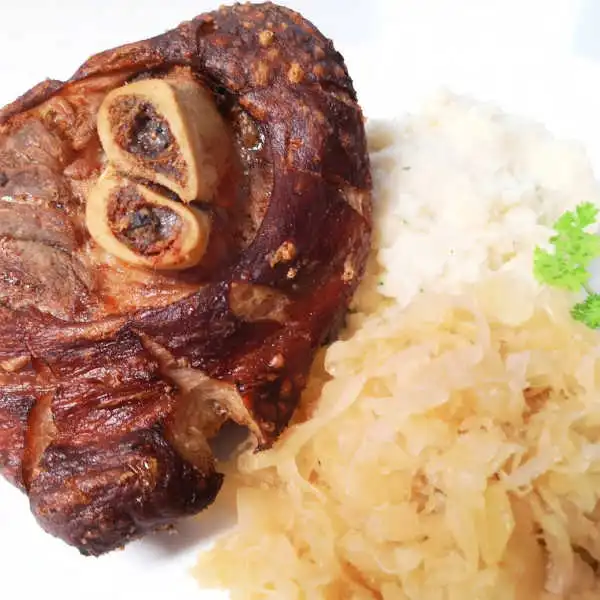 Here I've served the crispy-skinned pork hocks with sauerkraut and mashed potatoes. Mustard is on the side. Lecker!
Here I've served the crispy-skinned pork hocks with sauerkraut and mashed potatoes. Mustard is on the side. Lecker!Cooking Methods For Schweinshaxe
There are two basic recipes, both for schweinshaxe, the southern one, the one that's enjoyed in Bavaria. Both make REAL German food, Oktoberfest style!
- Oven-Roasted Schweinshaxe: This classic method slow-roasts the pork hocks in the oven until crispy and golden.
- Simmer and Roast Schweinshaxe: This gives a tender meat AND a flavorful broth to make the gravy (and extra for soups) AND is finished off in the oven being roasted until crispy and golden. This may sound like extra work, but it is SO WORTH IT!
Buying Pork Hocks: Tips And Tricks
- Check at your local butcher, German deli, or Asian markets for fresh pork hocks.
- When you buy the fresh pork hocks, try to find the meatiest ones you can.
- Depending on the size of the hocks, two meaty hocks will feed about three to four people. Served with boiled potatoes and sauerkraut, you've a traditional Oktoberfest meal.
- Check the fresh pork hocks to see if there are any hairs on the hocks before you cook them. If there are, the easiest way to get rid of them is to singe them off. Light a candle and hold the "hairy" hock over the flame, and the hair will "melt away".
How To Make Bavarian Pork Hocks:
(Find the printable recipe with measurements in the recipe card below.)
Gather your ingredients together and prep your veggies.
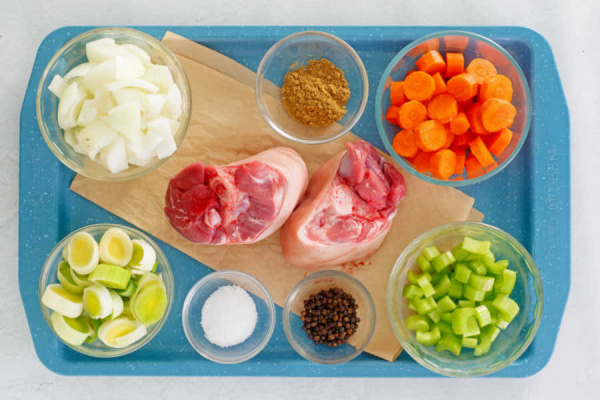 Gather ingredients for making the roasted pork hocks before starting. All into the pot and you're on your way.
Gather ingredients for making the roasted pork hocks before starting. All into the pot and you're on your way.Put all the veggies and spices into a large pot. Add the pork hocks and hot water. Why hot water? It helps to quickly seal the meat and keeps the meat tender.
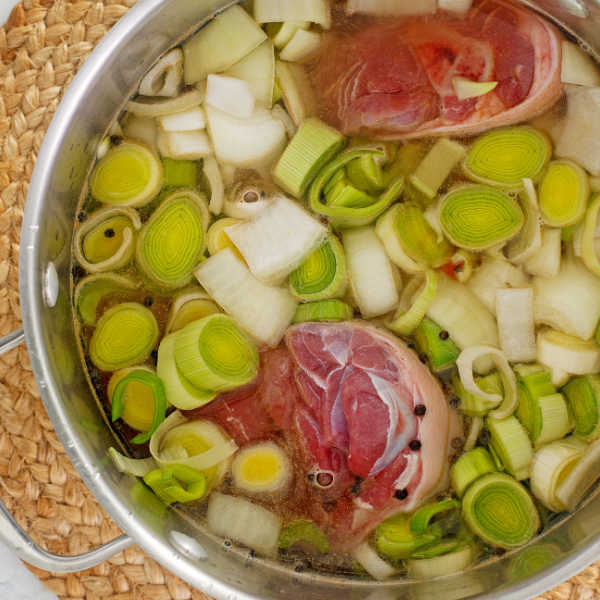 Put everything into one pot and heat to boil. Easy breezy.
Put everything into one pot and heat to boil. Easy breezy.Simmer until the meat is just tender.
Do not overcook or else the hocks will fall apart.
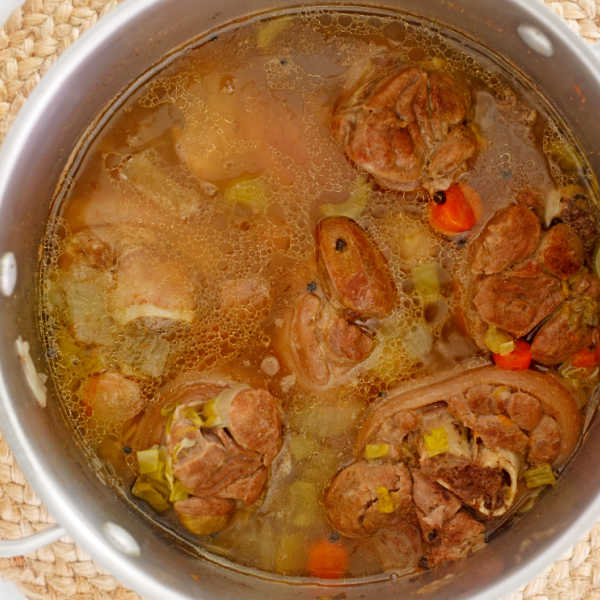 Cooked till just tender, these pork hocks are ready for the next step
Cooked till just tender, these pork hocks are ready for the next stepRemove the hocks with a slotted spoon and stand them in a baking dish. Strain the liquid and set it aside. Place the cooked veggies around the hocks.
Add just enough of the liquid to cover the bottom of the baking dish and keep the bottom of the hocks submerged. Try to keep the fat layer above the liquid to enable it to be browned.
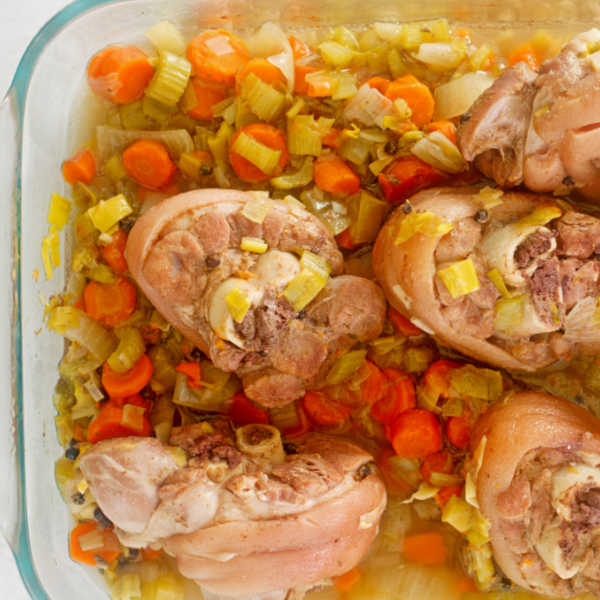 Pork Hocks ready for the oven
Pork Hocks ready for the ovenDepending on the oven, you may need to keep the hocks in for a bit longer than the 30 minutes to get the amount of 'browning' and 'crispiness' that you wish.
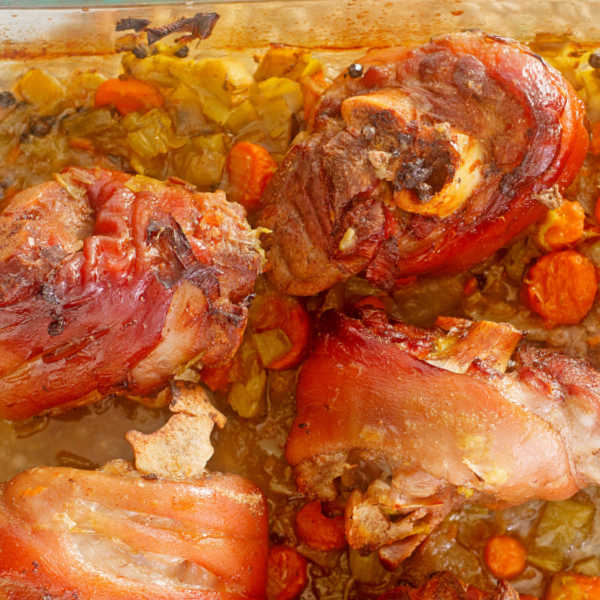 Roasted Pork Hocks still needing to go under the broiler to finish getting crispy
Roasted Pork Hocks still needing to go under the broiler to finish getting crispyIf they aren't getting brown and crispy enough (as shown above), turn on the broiler. Be careful though, that they don't burn.
Make sure that the base of the meat is in the liquid. To get a really crispy skin, do not baste the fat layer. It needs to be dry in order for the real browning to occur.
Fresh out of the oven, these pork hocks with their crispy skins are perfection!
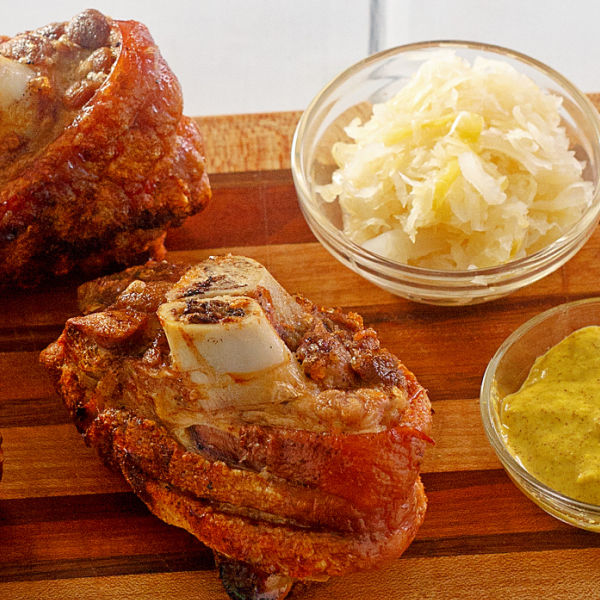 Crispy-skinned Pork Hocks, just like they are served in Bavaria. Sauerkraut and mustard on the side. Wunderbar!
Crispy-skinned Pork Hocks, just like they are served in Bavaria. Sauerkraut and mustard on the side. Wunderbar!Above, they are shown served with sauerkraut and mustard on the side. Enjoy with a cold beer or a refreshing glass of apfelschorle (apple spritzer) for a true German experience! Throw in some German brötchen and dinner's ready!
What To Serve With Schweinshaxe?
The roasted pork hock is the star of the show. Not much more is needed.
Top 10 Favorite side dishes include:
- Bread dumplings (Semmelknödel)
- Potato dumplings (Kartoffelklöße for us northern Germans)
- Sauerkraut
- Potato Salad (Kartoffelsalat)
- To see the rest of these favorites, click here!
Add a bit of gravy, some German mustard, and you're good to go. A big stein of your favorite beer, of course, is the drink of choice.
German Pork Hock FAQ
Is there a difference between ham hocks and pork hocks?
Is there a difference between ham hocks and pork hocks?
These are really the same part of the pig. Both are pork hocks, which are the ankle of the pig. However, the rear legs of the pigs are often called ham hocks.
Is there a difference between the schweinshaxe and the crispy pata?
Is there a difference between the schweinshaxe and the crispy pata?
Crispy Pata is a Filipino dish that's often served with a soy-vinegar dip. They are boiled pork hocks that are chilled and then deep fried, getting a wonderful crisp skin. Soul food, Filipino style.
Since the cooking method is different, the taste will be different. But, similar all the same. Of course, traditional German recipes don't routinely, if at all, use a soy-vinegar dip.
Give us that sauerkraut on the side and we're really happy :)
What are pork knuckles and pork shanks?
What are pork knuckles and pork shanks?
Pork knuckles are just another name for ham hocks or pork hocks. The pork shanks, also called ham shanks, on the other hand, are just above the pork hocks and are a much meatier cut.
Both, though, have a lot of skin, fat, and bones.
Can I use smoked pork hocks?
Can I use smoked pork hocks?
Smoked pork hocks are great, however they will make this dish taste like ham. If you want the traditional "pork hock" dinner, the type you get at Oktoberfest, then buy fresh pork hocks.
Are pork hocks a popular food in Germany?
Are pork hocks a popular food in Germany?
Originally, this was considered food for the poor people, aka Armeleuteessen, since it was made with inexpensive cuts of meat. Since this is a tough piece of meat, full of connective tissue, ligaments, and muscle, it needs to be cooked low and slow, to turn it into delicious fork-tender meat. Now it's become a specialty, especially in southern Germany.
Crispy Roasted Pork Hock (Schweinshaxe): German Pork Knuckles
German pork hocks recipe made easy! Get crispy, tender schweinshaxe with Oma’s tips, step-by-step help, and classic German side suggestions.
Prep Time:
15 minutes
Cook Time:
3 hours 30 minutes
Total Time:
3 hours 45 minutes
Servings:
2 servings
Ingredients:
- 1 leek, well cleaned, diced
- 1 stalk celery, diced
- 1 carrot, diced
- 1 onion, diced
- 1 bay leaf
- 2 meaty fresh, uncured, unsmoked pork hocks (1 pound or 454 g each)
- 2 teaspoons salt, divided
- 1 tsp black peppercorns
- 1 tablespoon caraway seeds (optional)
- cumin (optional)
- cornstarch (optional)
Instructions:
- Put vegetables, 1 teaspoon salt, 1 teaspoon peppercorns, bay leaf, and fresh hocks in a large pot or Dutch oven.
- Add hot water to cover, bring to boil over high heat. Lower temperature to a simmer and cook until hocks are just tender - about 2 hours. Do not overcook.
- Remove hocks with a large slotted spoon. Strain the rest, keeping both the vegetables and cooking liquid.
- Preheat oven to 425°F (220°C).
- Place hocks (well drained) in a standing position in a large roasting pan along with the drained cooked vegetables, and a small amount of the cooking liquid, just to cover the meat part and not the fat layer. Score the thick layer of skin and fat with a sharp knife in a diamond pattern. Dry the skin with paper towels. Rub the skin and the cuts with salt and caraway seeds (optional)
- Bake 30 minutes in the preheated oven, adding more cooking liquid if it evaporates, in order to keep the meat tender. Do not let the liquid touch the skin/fat layer. The internal temperature should be at least 165°F. If the skin isn't brown and crispy, turn on the broiler and continue browning. Keep watch that it doesn't burn. This could take 5 to 10 minutes.
- Serve the hocks immediately. If desired, make a sauce by thickening the cooking liquid with a tablespoon or two of cornstarch mixed with a little water and simmer briefly. Add a bit of cumin to the sauce if desired.
Notes/Hints:
- Keep the extra drained liquid from cooking the pork hocks. Use what's needed for the roasting process. Let the rest cool and refrigerate. Skim off the congealed fat and use the broth for soups or stews.
- One could cook the pork hocks in a slow cooker. Just be careful to only cook until just tender, or they will fall apart.
- You can use hot chicken broth instead of water to cook the hocks.
- If desired add juniper berries, garlic cloves or fresh herbs to the cooking liquid.
- Use a dark ale instead of the cooking liquid for the roasting process.
- If you're having trouble getting German pork knuckle, try going to Asian butchers. As well, asking for pork ham hocks or telling them you want to make crispy pork knuckle may get you the right cut.
- Sometimes the pork hocks have been cut into half pound pieces. Choose your sizes and quantities and adjust the recipe accordingly.
* * * * *
Unless otherwise noted recipe, images and content © Just like Oma | justlikeoma.com
Recipe updated on April 11, 2025
Comments? Questions?
You can leave a comment about this recipe or ask a question...
Pop right over to my private Facebook group, the Kaffeeklatschers. You'll find thousands of German foodies, all eager to help and to talk about all things German, especially these yummy foods.
Meet with us around Oma's virtual table, pull up a chair, grab a coffee and a piece of Apfelstrudel, and enjoy the visit.
Recent Articles
-
German Gingerbread House Recipe: Oma's Traditional Lebkuchen
Nov 13, 25 07:27 AM
German Gingerbread House Recipe: A simple, spiced lebkuchen, honey cake perfect for building and decorating your own festive holiday centerpiece. Fun and delicious for all! -
German Pork Noodle Soup – Oma's Nudelsuppe mit Schweinefleisch Rezept.
Nov 05, 25 09:50 PM
Homemade pork noodle soup ... so easy to make a huge potful to satisfy the hungriest of families or a large party. -
German Marble Pound Cake Recipe – Oma's Marmorkuchen Rezept
Oct 31, 25 08:13 PM
This favorite marble pound cake recipe has been in our family for years. It's a traditional German Marmorkuchen that's easy to make.
Words to the Wise
"For the Lord sees clearly what a man does, examining every path he takes."
Proverbs 5:21 (NLT)
